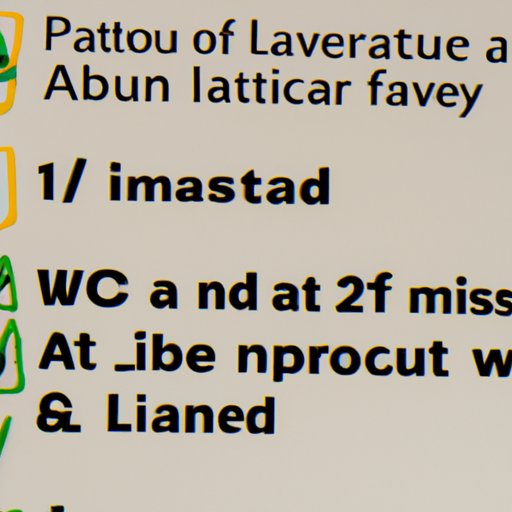Introduction
A1C is a type of blood test that measures average blood sugar levels over a 3-month period. It’s used to diagnose diabetes and monitor how well it’s being controlled. People with diabetes are advised to maintain an A1C level below 7%. An A1C that’s too high can put you at risk for serious health problems, including heart disease and stroke.
Making changes to your diet is one way to help lower your A1C levels. Eating the right kinds of foods can help regulate your blood sugar levels and reduce your risk of complications from diabetes. Read on to learn more about what to eat to lower A1C and how to plan meals for better blood sugar control.

Identifying Foods That Lower A1C
When it comes to managing A1C levels, the type of food you eat is just as important as when you eat it. Here are some of the best foods to include in your diet to help lower your A1C:
Complex Carbohydrates
Complex carbohydrates, also known as slow-release carbs, are digested slowly, which helps keep blood sugar levels stable. Complex carbs are found in foods like beans, oats, quinoa, barley, fruits, and vegetables. These foods are also high in fiber, which can help lower A1C levels even further.
Lean Protein
Protein is essential for maintaining healthy blood sugar levels. Lean proteins, such as fish, chicken, turkey, and tofu, can help stabilize blood sugar levels and reduce the risk of spikes. Protein-rich foods are also filling, so they can help you stay full longer and avoid overeating or snacking on unhealthy foods.
Healthy Fats
Monounsaturated and polyunsaturated fats are beneficial for people with diabetes. They can help reduce inflammation, lower cholesterol levels, and improve insulin sensitivity. Healthy fats can be found in foods like olive oil, nuts, avocados, and fatty fish, such as salmon and tuna.
Meal Planning to Balance Blood Sugar Levels
Eating the right type of food is only part of the equation for managing A1C levels. You also need to be mindful of when you eat and how much you eat. Here are some tips for meal planning to balance your blood sugar levels:
Understanding Glycemic Index
The glycemic index (GI) is a measure of how quickly a food raises your blood sugar levels. Foods with a low GI are digested more slowly, while foods with a high GI are digested quickly, resulting in a spike in blood sugar levels. Choosing low GI foods can help keep your blood sugar levels stable and reduce the risk of A1C spikes.
Portion Sizes
Portion size is another important factor to consider when planning meals. Eating too much of any food can cause your blood sugar levels to rise, so it’s important to pay attention to serving sizes. Aim to fill half your plate with vegetables, a quarter with lean protein, and a quarter with complex carbohydrates.
Regular Meals
Eating regular meals is also important for managing A1C levels. Skipping meals can lead to dramatic spikes and drops in blood sugar levels, so aim to eat three meals and two snacks per day. Spacing out your meals evenly throughout the day can help keep your blood sugar levels steady.
The Benefits of Eating Whole Grains and Fiber
Whole grains and fiber are two important components of a healthy diet. Whole grains are packed with vitamins, minerals, and fiber, which can help regulate blood sugar levels and reduce the risk of A1C spikes. Fiber-rich foods can also help you feel fuller longer, which can help you stay on track with your diet.
Sources of Whole Grains
Some examples of whole grains include oats, brown rice, quinoa, barley, wheat, buckwheat, and millet. These foods can be incorporated into meals in a variety of ways, such as adding them to salads, soups, and stews, or using them as a base for stir-fries and casseroles.
Including Fiber in Diet
Fiber is found in many plant-based foods, such as fruits, vegetables, beans, and legumes. Aim to include at least 25 grams of fiber in your daily diet. Some high-fiber foods include oatmeal, apples, broccoli, chickpeas, lentils, black beans, and almonds.

Understanding How Portion Sizes Affect A1C Levels
Portion sizes play an important role in managing A1C levels. Eating too much of any food can result in a spike in blood sugar levels, so it’s important to pay attention to serving sizes. Here are some tips for controlling portion sizes:
Controlling Serving Size
Try to eat smaller portions, but more often. This will help keep your blood sugar levels steady and reduce the risk of A1C spikes. If you’re eating out, try to split a meal with someone else or take home leftovers for the next day.
Avoiding Sugary Snacks
Snacks can be a great way to satisfy hunger between meals, but it’s important to choose snacks that are low in sugar. Avoid processed snacks, such as chips, cookies, and candy, and opt for snacks that are high in protein and fiber, such as nuts, seeds, and fruit.
Creating a Diet Plan with Low Glycemic Index Foods
Choosing foods with a low glycemic index (GI) can help reduce your A1C levels. Low GI foods are digested slowly, which helps keep your blood sugar levels stable. Here are some tips for creating a diet plan with low GI foods:
Examples of Low GI Foods
Some examples of low GI foods include whole grains, legumes, fruits, and vegetables. Other low GI foods include eggs, nuts, seeds, fish, and yogurt. Choose these foods instead of refined grains and sugary foods, which can cause your blood sugar levels to spike.
Choosing the Right Carbs
When choosing carbs, look for those that are labeled “whole grain” or “high-fiber.” These foods are digested more slowly than refined carbs, which helps keep your blood sugar levels steady. Try to include a variety of whole grains in your diet, such as oats, quinoa, barley, and wheat.

Incorporating Healthy Fats Into Your Diet for A1C Control
Healthy fats, such as monounsaturated and polyunsaturated fats, can help reduce inflammation and improve insulin sensitivity, which can help lower A1C levels. Here are some tips for incorporating healthy fats into your diet:
Sources of Healthy Fats
Healthy fats can be found in foods like olive oil, nuts, avocados, and fatty fish, such as salmon and tuna. Aim to include at least one source of healthy fat in each meal to help manage your A1C levels.
Benefits of Healthy Fats
In addition to helping reduce A1C levels, healthy fats have other benefits. They can help reduce inflammation and cholesterol levels, and improve heart health. They can also help you feel fuller for longer, which can help you stay on track with your diet.
Conclusion
Managing A1C levels is an important part of living with diabetes. Eating the right foods and planning meals properly can help reduce your A1C levels and reduce the risk of complications. Complex carbohydrates, lean proteins, and healthy fats are all important components of a healthy diet. In addition, choosing low glycemic index foods, controlling portion sizes, and eating regularly can help keep your blood sugar levels steady. By following these tips, you can help manage your A1C levels and reduce your risk of complications.
(Note: Is this article not meeting your expectations? Do you have knowledge or insights to share? Unlock new opportunities and expand your reach by joining our authors team. Click Registration to join us and share your expertise with our readers.)
